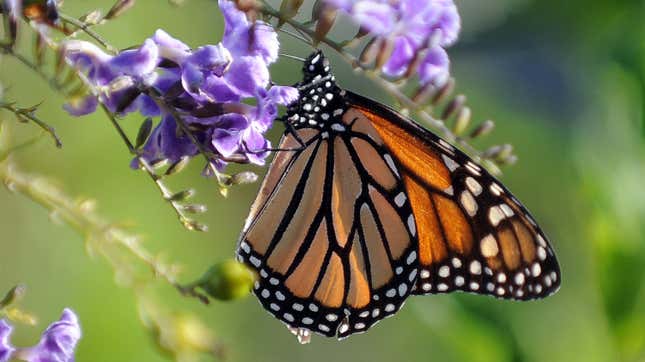
I do not like bugs. Creepy, many-legged things make my skin crawl. But as unpleasant as they are, insects are absolutely crucial for our world’s ecosystems to function, and sadly, new research shows that the creatures populations are on the verge of collapse.
That’s the theme of the latest issue of the Proceedings of the Natural Academy of Sciences, called the Global Decline of Insects in the Anthropocene Special Feature, which includes 12 papers conducted by 56 authors detailing insects’ rapid decline.
One reason for this decline is habitat degradation. As one of the studies shows, land use changes for agriculture are a major cause. “The industrialization of agriculture during the second half of the 20th century involved farming on greatly expanded scales, monoculturing, the application of increasing amounts of pesticides and fertilizers, and the elimination of interspersed hedgerows and other wildlife habitat fragments, all practices that are destructive to insect and other biodiversity in and near the fields,” the study says. The problem is widespread—right now, some 11% of the Earth’s land area is being used to grow crops and 30% more is used for grazing for animal agriculture.
The authors are particularly concerned about the impacts of agriculture in tropical regions, where deforestation to clear land for farming is common.
“Given that the great majority of insect species diversity is found in tropics, deforestation there surely ranks among the greatest threats to the world’s insect biodiversity,’ the study says. Since scientists estimate that less than 15% of the insects in the tropics have yet been discovered by humans, this means many species will go extinct before we even know they exist. That could make it difficult to understand what effects their loss will have on forest ecosystems at large.
The study’s authors also highlight the issue of the degradation of the world’s grasslands. Since so much prairie land is used to grow crops and feed animals, insects native to these places—including many kinds of butterflies, moths, ants, bees, and wasps—are among the most at risk.
An even larger contributor to insects’ perilous decline than the direct effect of land use changes, another study in the package shows, is the climate crisis. “From invasive species to habitat loss, pesticides, and pollution, the stressors of the Anthropocene are many and multifaceted, but none are as geographically pervasive or as likely to interact with all other factors as climate change,” the study says.
The authors conducted a meta-analysis of literature from long-term monitoring of insect populations, and found many instances of decreased numbers. In the mountains of California, for instance, increasing average daily minimum temperatures caused some butterfly populations to plummet, especially during drier years, because the warmer climate disrupted their mating schedules and access to nectar-producing plants. The same was true for moth populations amid warming temperatures in Finland and the UK, which had challenges maintaining their optimal body temperature.
In other places, though, insects actually thrived in the warmer weather. The authors found evidence of this in low-altitude parts of California and Central Europe. That’s because in some regions, the hotter temperatures helped larvae grow faster and caused some bugs to mate more often. This may sound like a good thing, but too many insects is a problem, too, as the huge populations can throw ecosystems and societies out of whack. Just look at the massive locust swarms that plagued East Africa last year, ravaging cropland in an area where many already suffer from chronic hunger.
Clearly, there’s a global need to ensure insect population levels stay where they’re supposed to be. In a perspective piece which contextualizes the 11 other articles’ findings, researchers lay out key ways world leaders could make this happen.
The efforts must include more careful monitoring the health and extent of insect populations as well as the stressors from rising temperatures to pesticide use. In addition to setting up new monitoring, the authors call for more resources to be put into analyzing existing data already out there, many of which are barely analyzed or not looked at at all. The new PNAS issue, for instance, includes the first-ever analysis of insect data from the U.S. Long-Term Ecological Research program since it was established in 1980.
Even if we don’t increase monitoring and analysis, the perspective’s authors say, we know enough for world leaders to take some immediate steps. They can work to curb the amount of land used for agriculture and the amount of pesticides permitted for use, and they can enact policies to rapidly decrease greenhouse gas emissions to quell the climate crisis. And scientists can work harder to communicate the importance of insect populations to the public, so the public will demand more efforts to protect bugs. Already, the perspective says, many insect populations are decreasing at annual rates of 1-2% a year, putting them on a collision course with extinction if we don’t reverse course.